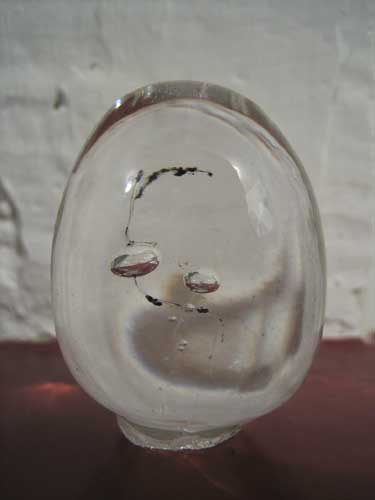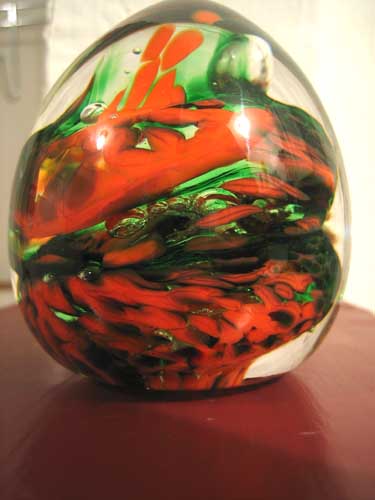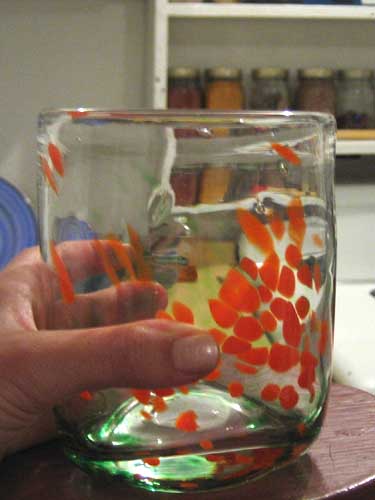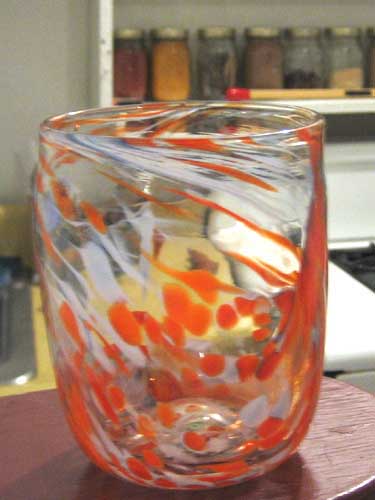How to Blow Glass
Those who can’t do, learn. In this installment of our series in which the clueless apprentice with the experts, we visit a glass-blowing studio in Brooklyn.
Until last Tuesday, the only molten material I’d ever worked with was chocolate. Even then, “licked off a spatula” is more accurate a description of what I did than “working.” But for the past 16 years, ever since my dad and step-mom took me to an exhibit of glass artist Dale Chihuly’s lilypad-ish flower-like sculptures, I’ve been fascinated by glass blowing. What wouldn’t be fascinating about manipulating a lava-like, potentially disfiguring substance and turning it into beautiful, breakable art?
Throughout my teenage years and into my 20s, I secretly held onto the notion I’d be a glass-blowing superstar if only given the chance to stick my iron in the fire, so to speak. Soon after I turned 30, a private lesson at Brooklyn’s Urban Glass, in Fort Greene, would test just how adolescent that notion was.
Over the phone, Urban Glass’s Director of Education John West promised me that after our three-hour lesson, I’d walk out with two paperweights and two tumblers. After walking into Urban Glass’s third-floor warehouse studio, the first thing I did was sign a release that promised I wouldn’t sue, even if the only thing I walked out with was a melted toe attached to my foot.
When John came out to the front room, he greeted me with the firm handshake you look for in someone who wields 2,000-degree material for a living. He spoke decisively, but with a laid-back swing that betrayed his California roots.
John gave me a brief tour of Urban Glass’s space. There were studios for neon, bead making, stained glass, mosaics, kiln casting. A man with a concentrated face behind his safety goggles sat in one of the smaller studios, shaping glass beads with a tiny, dense lick of flame. The halls were lined with artists’ bicycles and giant colorful vases that would soon be on the shelves of Tiffany’s. I felt that wisp of envy that comes with encountering people who have already mastered something you hope to someday be able to be proficient at.
In the main glassblowing area I caught sight of a young woman climbing a metal ladder as glass dripped from the end of her rod, at least 10 feet from the ground. Artists strolled from workstation to workstation with a measured abandon, and everyone wore all-cotton clothes—a must for safety reasons. No one enjoys getting burned, but it’s especially unpleasant to get burned and have one’s clothes melt onto oneself. Stuck to the walls was more than one Google map printout detailing the whereabouts of the nearest hospital.
“You ready to get started?” John asked.
“Yup.” Gulp.
How to Gather Glass
John handed me a long, thin, metal rod called a punty and gave me the rundown on how to gather some molten glass from a 2,000-pound furnace without creating a new swirl of color anywhere on my body.
Here’s the drill: Rest the rod on the sill of the furnace, bring your left hand all the way back, dip the rod in the molten glass, make three clockwise rotations of the rod, rest the rod back on the sill while continuing to rotate, put your left hand back out slightly to support the rod but not so far you land yourself in the hospital, and then remove the rod from the furnace while rotating.
In fact, there’s an acronym for it. It’s:
RTROTSOTFBYLHATWBDTRITMGMTCROTRRTRBOT
SWCTRPYLHBOSTSTRBNSFYLYITHATRTRFTFWR
It’s pronounced: “Shit, how am I gonna remember everything?”
When I had the pattern more or less down, we walked over to the furnace, and John warned me it was going to be hot when he opened the door, that I might be inclined to recoil. But he promised it would not blister my skin.
“It’s kind of like when you think you put your hand into hot water, so you pull it out, but it turns out it’s cold water,” he said. I didn’t fully understand—had the heat got to his head?—but I was prepared for a less than comfortable temperature shift.
I held the punty at the ready and John pulled back the door of the furnace. A formless, glowing, orange field of color appeared before me. It was so bright I could not see where the surface of the molten glass met the air. The acute heat gave me a wave of chills. I was glad John told me the air coming out the furnace wouldn’t blister my skin, because otherwise I would have believed it was turning me into Yushchenko. John told me later that sometimes when he opens the furnace door students drop the punty into the furnace and run away.
How to Roll Glass
As my chills subsided, I harvested a small amount of glass. “Pull your hand back,” John reminded me. I yanked it away from the furnace. “I’m sorry. I worry,” he added endearingly.
We walked over to a work station and he told me how to roll the glass on a steel table called a marver so it gets pushed up into almost a ball at the very top of the punty. This process is known, not surprisingly, as “marvering.” My marvering quickly turned the glass into something with corners. The cool steel makes it harden very quickly. Clop, clop, clop, it went on the table.
“Is anyone ever a natural at this?” I asked.
“Rarely,” John said. He did not mean I was one of the rare few.
Taking turns with the punty, we stuck the glass back in a heater called, I kid you not, the glory hole. Urban Glass rents out one of its glory holes at 69 dollars an hour. That’s all I’m gonna say on this front.
Once the glass was hot enough, it took on an orangey glow and we rolled it into a more desirable, curved shape. The glass extended about an inch and a half beyond the tip of the rod. Then it was time to sit down and rotate the punty parallel to the floor against two metal rails—one on either side of you—while using giant tweezers called jacks to squeeze an indentation around the edge closest to the rod.
I grabbed the jacks and went at it while John rotated the punty. “Squeeze,” he reminded me. You have to push harder than you’d think. The indentation was a little spirally, but it served. Then we used smaller tweezers (called tweezers) to drip two drops of water on the indentation. The water bubbled and steamed upon contact.
“There’s your first paperweight,” John announced. It had a swirl of black ash-like stuff in it and some bubbles in the middle, but he said it like it was something to be proud of. And I was, even if it was a little wonky.

John walked the rod—with the paperweight still attached—over to a slow cooling oven called an annealer. With a light tap to the rod, my little blob dropped gently into it. The annealer would cool down to 500 degrees overnight and then shut off, assuring that the glass didn’t change temperature too quickly and crack.
How to Color Glass
“Let’s do another one, with color,” he said.
Glass colorant, known as frit, is little bits of pigment the size and shape of Grape Nuts. I picked orange and translucent green. John poured some of the frit out of its Gladware container onto the marver.
We went through the process of gathering glass again, but this time we went over to a metal tub afterward and cooled the rod using a long thin pail of water with a hole along the length of the bottom. It steamed and hissed dramatically.
“Itsgootuhcooomm…” John said, looking at the rod.
“What?” The white noise from the ventilation system and seemingly countless fans was so potent I couldn’t hear John at all if he spoke with his head turned away from me.
I had made the kind of thing my mother would love, and not only because her kid made it. It was surprising and exhilarating.
“It’s good to cool the rod from the end to the tip.”
It was time to roll the glass over the frit, picking up the bits of color. We reheated the glass and rolled some more. Then, so as to ensure that the color would be embedded in the middle of the paperweight, I dipped the punty back in the furnace and gathered some more clear glass around what I already had. The frit melted and swirled inside my paperweight-to-be.
“That was a great gather. You are a natural,” John said. I don’t know if he was just buttering me up, but I felt a rush of elation. “Keep rotating,” he reminded me. Elation and rotation should not be mutually exclusive, I learned.
Back down to the seat I went as John rotated the punty. “Grab the block,” he said. I pulled a wet chunk of scooped-out wood on a handle out of a water-filled bucket behind me. Rotating the glass in the block gives it more shape than gravity alone could provide. John stuck the glass back into a heater, advised me to quench the block again—that is, dip it back into the bucket—and then to choke up on it—that is, to hold the block high up on the handle. We did a little more shaping before it was time to make another indentation with the jacks, drop a little water onto the indentation, and—boom—second paperweight done.
This one was substantially bigger than the first, probably three inches tall, and it had cirrus clouds of color wisping through it. I vowed to start writing letters in windstorms just to have a use for this paperweight.

I had made the kind of thing my mother would love, and not only because her kid made it. It was surprising and exhilarating.
How to Shape Glass
“You ready to make a tumbler?”
This was not really a question.
The tumbler began much like the paperweights, only I got to blow a bubble into it and the sides required shaping with a thick, soaking piece of newspaper that literally caught on fire upon contact with the with the glass. Flames snaked up inches above my hand. Safely on the other side of the newspaper, they didn’t burn me. We made a flat bottom using a wet wooden paddle. Still, my tumbler did not look like a tumbler. It was the shape of a sandbag sitting on a table and tied at the top. To open it up, we brought over a third person—a cheerful and palpably smart Southerner named Lindsey—who gathered a tiny amount of molten glass onto another rod and slowly brought it near the base of my tumbler. I used the tweezers to affix it right in the center. Then with those miracle two drops of water and a tap on the pipe, my tumbler loosed itself from the pipe and held tight to the rod Lindsey was holding. It now had a tiny, jagged rim at the top.
To open up that rim, we reheated the glass, then I held the jacks inside the rim at a low angle and slowly let the tongs open as John spun. It opened up like a flower in fast motion. But the heat was so intense, someone had to hold the paddle between the opening of the tumbler and my arm. Luckily, Lindsey had urged me to slip my arm into “the sleeve,” a buttercup-yellow one-size-fits-all cylinder of fabric that closely resembles cotton candy or fiberglass insulation. Only not sticky or itchy.
Later, John told me about a guy with tattoos up the length of his arm who got a substantial blister that permanently distorted one of them. And John admitted that his right arm used to be burned almost constantly before he had children and became less inclined to damage himself. Back in the day, he told me, he and his studio buddies used to try to explode furnaces. Knock on the block, I walked away without any injuries save for that slight heat rash, which I get almost any time the temperature goes above 90 degrees anyway.
John said, “You’ll have a career if you keep at this.” I’m not sure my first tumbler is a testament to that.

Nor my second tumbler.

But get me in that sleeve again, hand me a punty, a pipe, a marver, some jacks, some wet newspaper, a paddle, a block, some tweezers, an annealer, a bunch of frit, and, what the hell, an RC Cola, and I’m ready to make me a lilypad-ish flower-like sculpture of my own. After a few—or a few thousand—more lessons.
